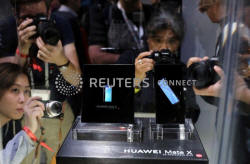Look but don't touch as smartphone's flexible future
unfolds
 Send a link to a friend
Send a link to a friend
 [February 26, 2019]
By Paul Sandle [February 26, 2019]
By Paul Sandle
BARCELONA (Reuters) - Flexible and folding
formats framed the future of smartphones this week as manufacturers
focused on new forms in an effort to jolt the market out of uniformity
and re-invigorate sales.
But anyone hoping to tap or swipe Huawei's Mate X, a smartphone that
wraps the screen around the front and back, was soon disappointed at
Barcelona's Mobile World Congress.
(Graphic: Smartphone unit sales by vendor 2018 - https://tmsnrt.rs/2VgEOXM)
Initial cheers were quickly followed by gasps when the Chinese firm
revealed its eye-watering 2,299 euros ($2,600) price tag, although that
includes a 5G connection.
This is even more than Samsung's Galaxy Fold, which was unveiled last
week and will be priced from $1,980 when it goes on sale in some markets
in April. It was on display in Barcelona in a glass case like a museum
artefact.
While the hands-off stance indicates neither firm has a consumer-ready
device, 2019 would be remembered as the year of the foldable Ben Wood,
chief of research at CCS Insight, said, adding that the new format was
still in its infancy.

"But we are at the stone age of devices with flexible displays; it's a
whole new phase of experimentation after the sea of smartphone sameness
we have seen for the last decade."
Samsung took the opposite approach to Huawei by putting its folding
screen on the inside of its device, with another smaller screen on the
front panel for use when its is closed.
"That was the solution we felt was best for longevity," Samsung's
European Director of Mobile Portfolio & Commercial Strategy Mark Notton
told Reuters.
Smartphone makers have been trying to innovate to persuade consumers to
upgrade from devices which already meet most of their needs, in an
effort to reverse falling sales.
And although more vendors will soon follow with their own takes on
foldable displays, 2019 will not be the year they go mainstream, market
analysts Canalys said. They will remain exclusively ultra-luxury devices
with fewer than 2 million expected to be shipped worldwide this year,
Canalys added.
[to top of second column] |

People take pictures of the new Mate X smartphone, ahead of the
Mobile World Congress (MWC 19) in Barcelona, Spain, February 24,
2019. REUTERS/Sergio Perez

The mobile market slipped 1.2 percent in 2018, research company Gartner says,
although it expects growth of 1.6 percent in 2019, driven by replacement cycles
in the largest and most saturated markets China, the United States and Western
Europe.
GEARING UP FOR 5G
With 5G next generation mobile networks not becoming widely available until 2023
in the United States and China and 2026 in Europe, analysts say, the vast
majority of customers will be buying the latest 4G devices like Samsung new
Galaxy S10.
Nonetheless, manufacturers such as LG were keen to show they could squeeze 5G
technology into 4G smartphone form, although most lacked launch or pricing
information.
Chinese maker OnePlus had a 5G device running a video game using a 5G connection
on show, but visitors were teased with only a glimpse of the phone's screen in a
display cabinet.
"For us, launching means commercial availability, it doesn't mean PowerPoint,"
OnePlus co-founder Carl Pei told Reuters.
"We are confident we are going to be one of the first with a commercially
available smartphone in Europe," he said, adding that this would be within the
first half of 2019.
Xiaomi Corp, which ranked fifth in smartphone shipments in the last quarter
according to IDC, did reveal pricing information along with its first 5G device.
"Xiaomi has fired the starting gun with a $599 price. That will bring tears to
the eyes of many other mobile phone makers," Wood said, adding that many
sub-scale makers such as Sony, LG and others could find it tough to make any
kind of margin on 5G.
Sony did not show a 5G device, relying instead on its ownership of a major
Hollywood studio to release a new line of Xperia phones with a 21:9 display
ratio optimised to watch movies and Netflix content.
(Additional reporting by Douglas Busvine, Jack Stubbs and Isla Binnie; Editing
by Alexander Smith)
[© 2019 Thomson Reuters. All rights
reserved.] Copyright 2019 Reuters. All rights reserved. This material may not be published,
broadcast, rewritten or redistributed.
Thompson Reuters is solely responsible for this content.
 |